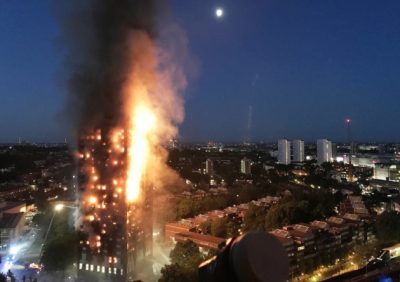Grenfell Tower: Local Authority Accused of Multiple Manslaughter and Government Officers of Dereliction of Duty

Grenfell Tower in North Kensington, London, was completed in 1974, as part of the first phase of the Lancaster West Estate. The Owner being Kensington and Chelsea, London Borough Council whilst the Landlord was Kensington and Chelsea Tenant Management Organisation (KCTMO). The building’s top 20 storeys eventually consisted of 127 flats and 227 bedrooms, after a major refurbishment in 2016.
Plans by Studio E Architects for renovation of the tower were publicised in 2012. The £8.7 million refurbishment, undertaken by Rydon Ltd of East Sussex in conjunction with Artelia for contract administration and Max Fordham as specialist mechanical and electrical consultants. As part of the project, the concrete structure received new windows and new aluminium composite rainscreen cladding, in part to improve the appearance of the building.
Two types were used: Arconic’s Reynobond PE, which consists of two coil-coated aluminium sheets that are fusion bonded to both sides of a polyethylene core; and Reynolux aluminium sheets. Beneath these, and fixed to the outside of the walls of the flats, was Celotex RS5000 polyisocyanurate (PIR) thermal insulation. The work was carried out by Harley Facades of Crowborough, East Sussex, at a cost of £2.6 million.
In January 2016, the residents Grenfell Action Group (GAG) warned that people might be trapped in the building if a fire broke out, pointing out that the building had only one entrance and exit, and corridors that were allowed to fill with rubbish. GAG published an online article attacking KCTMO as an “evil, unprincipled, mini-mafia” and accusing the council of ignoring health and safety laws. In the blog post, they warned that “only a catastrophic event” would “expose the ineptitude and incompetence of [KCTMO]” and “bring an end to the dangerous living conditions and neglect of health and safety legislation” at the building.
Critically, the London Fire Service was never consulted and was never told that this then structurally sound, fire safe building was to be transformed by the landlord into a potential death trap by the decision to cosmetically clad the entire structure in inherently dangerous, isocyanate based, polymer foam panels that were a fire accelerant which under conditions of high temperature would also emit lethal hydrogen cyanide gas that could kill in minutes and which was then banned from use in residential buildings in many parts of the world.
In fact, a fire broke out on 14 June 2017 and lasted 72 hours. Emergency services received the first report of the fire at 00:54 local time and it burned for around 24 hours. Initially hundreds of firefighters and 45 fire engines were involved in efforts to control the fire, with many firefighters continuing to attempt to control pockets of fire on the higher floors after most of the rest of the building had been gutted. Residents of surrounding buildings were evacuated due to concerns that the tower could collapse, though the building was later determined to be structurally sound.
There was no way that all those in the building at the time of the fire could have been evacuated and saved by the emergency services and to endeavour to lay the blame on the London Fire Service for what was a prima facie gross criminal negligence on the part of the owners and managers of the building, is clearly an overt attempt to shift the blame and responsibility for the loss of 72 lives away from those who were actually responsible.
That is both a failure of both central and local government, and of justice, which must be rectified without delay – and not in another two years. The incoming government must take immediate action to identify and prosecute those responsible for the greatest civilian loss of life in a residential building since World War 2.
A further public enquiry is, at this juncture, considered both unnecessary and an unacceptable postponement of justice as the names of those alleged criminally responsible are already in the public domain and, as far as is known, are now still within the jurisdiction of the British courts.
*
Note to readers: please click the share buttons above or below. Forward this article to your email lists. Crosspost on your blog site, internet forums. etc.
Hans Stehling (pen name) is an analyst based in the UK. He is a frequent contributor to Global Research.

